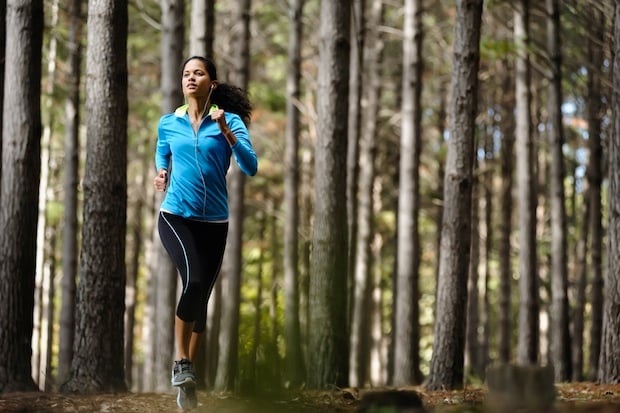Don’t get us wrong—we love running the Monument loop and through the streets of DC. But urban running has its downsides: catching every single red light, inhaling car exhaust, and weaving through pedestrians on the sidewalk, to name a few. That’s why Doug Hay of the blog Rock Creek Runner switched from road running to trail running a few years ago. “When I moved to DC I was running just roads, until three years ago when I realized we have so many trails in our backyard.”
But the transition to trail running isn’t easy, says Hay, who does approximately 70 percent of his training on trails. One thing to get used to? Getting wet. “No one loves running in wet shoes,” Hay says. “But there’s just no way to not get your shoes wet.” Read on for more of Hay’s trail running tips.
1) Go slowly.
Those used to running on the road may find going slower on trails the hardest adjustment, says Hay. “My advice to people when first starting out is to not focus on pace or distance.” For example, instead of timing a three-mile trail run, plan to run for 30 minutes and “just see how far you go.”
2) It’s a good way to give your joints a rest.
Trail running can give your shins, knees, and joints a break from the impact of running on pavement. Still, be careful with your footing and watch out for roots and rocks.
3) Expect to be sore in new places.
While your legs will welcome the lower impact of trail running, some muscles may take a new beating. “You’re definitely going to work some muscles you wouldn’t normally, like the stability muscles in your hips and ankles,” says Hay. Consider strengthening those muscle groups by including exercises such as calf raises, ankle rolls, and hip flexor stretches in your regimen.


 4) You won’t need new shoes—yet.
4) You won’t need new shoes—yet.
There are specific running shoes for serious trail runners (Hay runs in New Balance 110s), but you don’t need new shoes if you’re running just a few miles. The major difference between a typical running shoe and a trail running version is that the latter has a rock plate in the sole to offer protection against rocks and foot injuries, Hay explains.
5) Don’t be afraid to get dirty.
Whether you’re running on a horse path in Rock Creek Park or through a stream somewhere in Shenandoah National Park, you’re bound to emerge from the trail with some dirt or bruises. “Part of the appeal is running through creeks and mud puddles and doing things you would never do,” Hay says. “But that’s part of the experience—getting closer to the ground and feeling more a part of your surroundings.”
6) Start with an easy trail.
Hay recommends trying your first trail run in Rock Creek Park, which offers 13-plus miles of horse paths. Once you have a few trail runs under your belt, other options are Potomac Heritage Trail, Fountain Head State Park, and trails in Sugar Loaf Mountain or Shenandoah National Park, which include extra challenges with its elevation changes.
You Might Also Like:

Tips for Running an Ultramarathon |

How an Ironman Athlete Eats |

8 Helpful Tips from Triathletes |


















